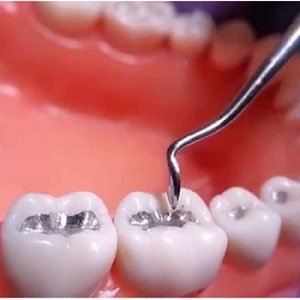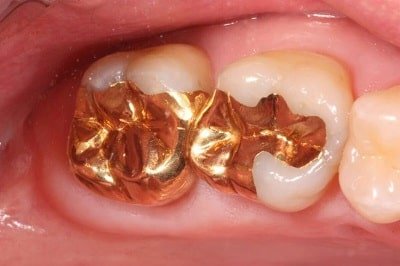Many people are scared about dental procedures especially when they think they will hurt. There is actually have nothing to be afraid of. People wonder about “is tooth fillings painful or not?” But actually, tooth fillings are not as bad as people think. in this article you will get brief detail about whether Tooth Filling painful? and Types and their causes.
A tooth filling is basically a treatment that is used to restore the function, integrity, and morphology of a missing tooth structure resulting from an external trauma. A tooth filling is probably known as dental restoration or dental fillings. A tooth filling is an artificial substance that is used to fill in the gaps or holes in the enamel of decayed, broken, and damaged teeth.
During a filling, you are unlikely to feel pain. The filling is not taking place in such areas of the tooth where there are nerves because of it there is no nerve cutting happen so you should not feel pain during the filling procedure.
Whereas some people have sensitive teeth or require deep fillings that come closer to the nerves. In this case, dentists used an anesthetic to numb your mouth during the filling procedure. In order to avoid pain dentists generally, give an anesthetic injection that ensures the particular area will not feel anything. It is an extra measure to ensures that you would not feel any pain from filling.

STOP ANY KIND OF TOOTH PAIN, GUMS PAIN, AND TOOTH DECAY WITH THIS Simple TRICK ( Watch Now)
How Long Does a Tooth Filling Take?
Generally, tooth filling procedures vary according to the size of the cavity and the location of the cavity. The average time of tooth filling is ranging from 20 minutes to an hour. Tooth filling also depends upon the material that is used for filling. Sometimes it takes an hour to fill and sometimes it requires a second visit. For instance:
- Composite resins materials that filled in to the tooth took longer time but it completed in a single visit.
- Gold filling and porcelain filling cannot be done in a single visit. In first visit, cavity will be removed and made an impression of your mouth. In second visit the filling is placed to your tooth.
The tooth filling procedure started after numbing your mouth with anesthetized on that particular cavity. After that, the decaying part of the tissue will be removed and the remaining part of the tissue shaped according to the filling. While these steps are quite the same in every type of filling and it is also done within a small time. There are some factors that tell us about what’s happening in later steps and how long does filling takes. These factors depend upon the nature of the material that is used in filling and the type of filling which is recommended by the dentist or it may the choice of patients.
Types of Tooth Filling
Today, several types of dental filling materials are available. Fillings can be done with gold, porcelain, silver amalgam, or tooth-colored, plastic, and resin fillings.
Silver Amalgam Fillings
One of the most common and popular tooth fillings is an amalgam (silver) tooth filling that consists of different materials including Tin, zinc, copper, and mercury. Dentists use this type of filling for so long especially on back teeth because it is long-lasting and sturdy and less expensive than others.
The typical amalgam filling can stand up to 12 years or more. The amalgam filling is also pretty easy for dentists to treat the cavity because it’s malleable.
The main drawback of an amalgam filling is that it is not aesthetically pleasing, so it is not a good choice for highly visible teeth. Its material can also respond to temperature changes by expanding or contracting over time that causes tooth crack. These fluctuations can create spaces between the tooth and filling, ushering in food and bacteria and the formation of new cavities Moreover, amalgam fillings can cause discoloration to the surrounding tooth structure.
Approximately 1% of people are allergic to the mercury that is present in amalgam filling material. Despite the controversy surrounding mercury in the amalgam filling material has been declared safe for use.
Gold Fillings

Another material that is used in tooth filling is Gold. One of the best gold filling advantages is its durability and strength. Gold filling lasts at least 10-15 years or more and it doesn’t corrode. It can withstand chewing forces. Moreover, it aesthetically pleasing to some people than a silver filling.
The main disadvantage of Gold Fillings are more expensive than other filling materials is 10X time expensive than silver amalgam fillings. Additionally, it requires at least two office visits to place. Also, it causes sharp pain when a gold filling is placed immediately next to the silver filling. Plus, many patients don’t want people to see their fillings and gold-like-silver fillings are visible in the mouth.
Tooth-Colored Composite Fillings
Composite Fillings are composed of plastic and resin materials. usually, people are more likely to choose composite fillings over other fillings because dentists will replicate the tooth color with this composite material.
Composite fillings micro mechanically bonds to the tooth structure and providing further support. Additionally, composite fillings are very versatile and can fix the chips in the teeth and modify small gaps.
The disadvantage of composite fillings is that they are not as long durable and strong as amalgam fillings. It also increases the chair time because it can take up to 20 minutes longer than the amalgam fillings. Composite fillings cost twice the cost of amalgam fillings.
Ceramics Fillings
Ceramic fillings are usually made up of porcelain which makes them more durable and strengthens and It can last more than 15 years. Ceramic fillings is also having higher rates but it is less expensive when compared to gold fillings but they are Tooth-colored and resist stains and abrasions better than composite fillings.
Glass ionomers Fillings
Glass ionomers fillings are generally used for children. These filings are made up of acrylic and a type of glass. This type of filling is used below the gum line and in small cavities. These fillings can be done away from the chewing surfaces.
Due to acrylic in nature, it releases fluoride to that particular tooth which protects the surrounding area of teeth from further decay and it provides strength to that area.
However, glass ionomers material for filling is quite weak thus the dentists used this filling for only small cavities near the gum line.
Causes of Tooth Filling Painful:
Bacteria that are present in your mouth made a layer over the teeth called dental plaque.
When you eat food and drinks that are highly rich in carbohydrates, mainly sugar-containing food, drinks, and beverages, the bacteria which is present in plaque break the carbohydrates into energy they need to survive. So by the breakage of these carbohydrates, they produce acid at the same time. This acid formation affects the tooth by forming holes which are called a cavity.
Here is how tooth decay develops:
- Plaque forms: Teeth are covered by a sticky layer which is called plaque formed due to usage of a lot sugars and starches. It is also formed when you did not clean your teeth regularly. When these sugar and starch containing substance are not cleaned off properly then the bacteria break such compound into their energy and feed them. This plaque sticks to your teeth under or may above the gum line. It turns to tarter that makes the plaque more difficult to remove and it provide shield to bacteria.
- Plaque attack: After acid formation it removes the minerals in your tooth that made your tooth harden or made erosion on the surface of teeth. Erosion cause the formation of holes in the tooth’s surface.
The bacteria that are present in your mouth entered the next layer of your teeth after making holes in them. The next layer of teeth is called dentin which is very softer than the enamel. These layers contain tiny tubes that is directly communicated to the nerve of the tooth that causes sensitivity.
- Destruction continues: When tooth decay starts the bacteria and acid continues to run throughout your teeth and reached at the inner part of the teeth called pulp, which contains blood vessels and nerves.
Due to acid and bacteria accumulation in pulp, it becomes swollen and expands inside of a tooth thus the nerve pressed which causes pain. This disturbance of the tooth may expand outside of the tooth root to the bone.
Summary
We’re taking about either tooth filling painful or not? During this tooth filling procedure, you’re not feeling pain because that particular area is anesthetized that numbs your mouth, and filling is done by the dentist via following different procedures and types.
According to the patient’s cavity size and location, it is decided which type of filling is best for that particular patient and how long it continues. Tooth Filling may painful after filling when patient doesn’t care about cleaning regularly that is major cause of pain as well as tooth decay.
About filling treatment, you have no need to worry about it because there are many measures that have been done before treating. You can consult your dentist after knowing the ways of filling and choose the best. If this information is helpful, then you can inform us via commenting or may you can send a feedback by clicking on contact us. Or if you have any questions regarding tooth filling painful you can ask just tap on contact us , we’re right here to help just a click away.
You can also share your experience if you had done any of the filling treatments and can share your medication.
FAQ’s
Is it normal to have tooth pain after a filling?
Yes, it is absolutely normal to have some pain after tooth filling but it will be gone in 2 or 3 days’ time and afterward, you will not feel any pain. If the tooth filling painful for you then tell it to your dentist from where you have done the tooth filling process.
Is it normal to have tooth sensitivity after a filling?
Tooth fillings are safe and very much effective but some patients can feel sensitivity and pain after a tooth filling. Yes, it is normal to feel sensitivity but don’t worry this will go away within a week.
Headache after dental filling?
Headache is the most common problem after any dental work, and dental tooth filling painful when it will affect you with a headache but you don’t need to worry it will be all right after a few days’ time.
Nerve pain in tooth after filling?
Nerve pain is the main cause for having sensitivity in your teeth and is common and it is a short-term pain that occurs because of inflamed nerves inside the tooth after the filling procedure. and it can discomfort you.